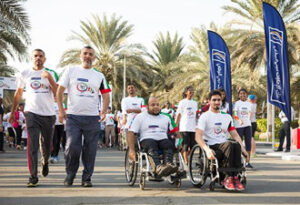Nightingale has put together few thoughts to help kick-start a healthy new lifestyle in the foggy mornings and evenings that January brings.

As many of us dust off the trainers and embark on finding the healthy people we once were prior to the dawn of the New Year we at Nightingale, want to help you achieve your goals. Motivation can be hard to find in the foggy mornings and evenings that January brings so we’ve put together a few thoughts to help kick-start a healthy new lifestyle. And yes we did mean lifestyle! Think of exercise as a habit. Habits need around 3 months to form meaning that whatever you start now will only become a habit by April. So how do we start the habit and more importantly how do we keep the habit…
Think about it like this:
If you want to keep your New Year’s resolution, start small. Figure out a reasonable amount of time you can dedicate to exercise and choose an activity that won’t result in overexertion. For example, you could try incorporating a walk to work instead of driving or doing a 10-minute circuit of push ups, sit ups, step ups and squats in your own home.
Small, achievable routines with few potential obstacles are more likely to remain part of your life in three months time. Then, once they’re a habit, you can gradually add more activities, branching out and finding further ways to increase your fitness. Even a 1% daily increase in activity will eventually add up to an incredible lifestyle and health change by this time next year.
Create a plan – Before you start your exercise program, answer three questions.
- When will you exercise? Identify three days and times that are convenient for you and stick with those days so you are working out at the same time each week.
- What type of exercise will you do? The best type of exercise is one you enjoy. Don’t worry about what everyone else is doing; pick an exercise that works for you. Choose from activities such as walking, cycling, running, swimming, weightlifting, skating, dancing, golf, handball, tennis and basketball.
- How much time will you spend exercising? Start with as little as 10 minutes per session and slowly build up to at least 30 minutes per workout.
Set a goal
Make sure it’s achievable and realistic. For example, trying to lose 5kg by Easter or run 5km in 12 weeks are only examples of what you might want to achieve. Remember that your health will benefit from the smallest of changes to activity in your daily routine.
Bring a Friend
Exercising alone can be daunting so bringing a friend or social group along to accompany you can help motivate you. Whether it’s a Saturday morning group walk, early morning pilates session or gym session at lunchtime, having a group of people around you will help inspire you. And for those days that you struggle to get to the session, knowing people are waiting for you can help get you there.
You are more likely to succeed if you;
- Have confidence in your exercise ability.
- Receive encouragement and support from those closest to you.
- Participate in an enjoyable form of exercise.
INJURY PREVENTION TO ACCOMPLISH YOUR NEW YEAR’S RESOLUTION
The month of January is a busy time in most gyms or training centers. Many people attempt a comeback or a first experience at the gym, hoping to get into shape as part of their New Year’s Resolution. But even with the best of intentions, the risk of injury is very real, particularly when it comes to a return after a long period of inactivity.
Some injuries that are recurrent in gyms:
- Back pain
- Tendinitis and other inflammatory injuries
- Pulled muscle
Although these injuries are considerably different, their causes are often similar:
- Lack of a warm-up
- Lack of lumbar and abdominal stability
- Overload/overtraining
- Bad technique/form
- Lack of stretching after exercise
- Short recovery time

People most at risk of injury
Although even a person in optimal physical condition is exposed to injury during training, some characteristics increase the risk injury such as having a sedentary lifestyle, age (more likely to have osteoarthritis), and being overweight. In the case of people with a sedentary lifestyle, injuries often occur from lack of muscular endurance. Aging people, for their part, may have to deal with osteoarthritis and in some cases problems with limited physical capabilities. While overweight people often suffer from joint problems, especially in the knees, that limits their capacity to do many activities in weight bearing.
Some tips for prevention
For beginners, it is recommended to:
- Use a training program developed by a Personal Trainer. Most gyms offer this service or you can always seek out independent trainers. This is a good way to learn the right techniques and to become familiar with the equipment. In addition, a Trainer will be able to create a training program based on your current situation and your goals (weight loss or muscle gain).
- Always complete the cardiovascular aspects of your exercise program. Running, stationary bikes and elliptical trainer are great warm-up exercises for the whole body. However, these exercises should be taken on gradually.
- Begin training with shorter sessions and increase over time, but always do so gradually.
- Warm uplifting very low loads, then increase the resistance (for those who want to focus on gaining muscle mass).
- Do not work for the same muscle groups two days in a row. A good frequency to start strength training is 3-4 times per week. Anyone wishing to train every day should alternate between upper body and lower body.
- Ensure you have a good lumbar and abdominal stability before embarking on weight exercises.
For those who make a return to training after a long absence:
- It is important to make a gradual return to regain muscle memory. Do more repetitions with less of resistance at first. After 4-6 weeks, you should be able to pick up the pace you were at before. Once it becomes easy to perform 20 reps with a certain load, it is a good indicator that it can be increased.
- With some training objectives, such as increasing muscle mass, for example, require higher loads at a lower number of repetitions (between 6 and 12), it is still preferable to work endurance in the first weeks by lifting lower resistance (12 to 20).

What to do in case of injury
Of course, it is strongly recommended to promptly consult a medical professional for an injury or even when you have concerns. An untreated injury can cause other problems, such as compensation from other muscles. This can cause overuse and add on additional injuries. A person wishing to continue training after an injury must ensure that it heals properly to avoid further repercussions. A Physiotherapist can prepare a training program with exercises specifically tailored to the injury. Physiotherapists are also often called upon to work with Personal Trainers because they can modify the training programs accordingly. All in all, no one should be deprived of physical training because of the fear of injury. The benefits of a healthy body, short and long-term, far outweigh the possibility of injury, especially when these risks are minimized by good training and recovery methods.



